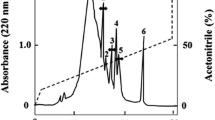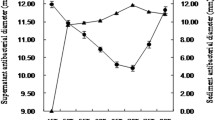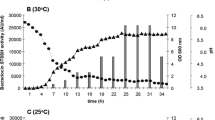Abstract
Bacteriocin produced by Lactobacillus plantarum strain LR/14 was purified to homogeneity by a multi-step protocol consisting of ammonium sulfate precipitation, cation-exchange chromatography, gel-filtration, and reverse-phase FPLC. L. plantarum LR/14 secreted a low-molecular-weight bacteriocin consisting of two peptides designated as plantaricin LR14α and -β with molecular mass of 3,012.46 and 5,605.74 Da, respectively. The purified peptides were characterized to be highly thermostable and active in acidic pH range, with a pI of >10.0. Both α and β peptides showed bactericidal mode of action against indicator strain, Micrococcus luteus and together showed a synergistic action. These peptides were differentially sensitive to a range of proteolytic enzymes, indicating differences in their composition. Amino acid sequencing revealed that the N-terminus in both the cases is blocked; thus, only a partial sequence could be obtained after CNBr digestion. These sequences, when compared with those available in the database, showed no homology with known bacteriocins, indicating it to be a novel compound.




Similar content being viewed by others
References
Abee T, Krockel L, Hill C (1995) Bacteriocins: mode of action and potentials in food preservation and control of food poisoning. Int J Food Microbiol 28:169–185
Albano H, Torodov SD, van Reenen CA, Hogg T, Dicks LMT Teixeira P (2007) Characterization of two bacteriocins produced by Pediococcus acidilactici isolated from “Alheira” a fermented sausage traditionally produced in Portugal. Int J Food Microbiol 116:139–247
Barefoot SF, Klaenhammer TR (1983) Detection and activity of lactacin B, a bacteriocin produced by Lactobacillus acidophillus. Appl Environ Microbiol 45:1808–1815
Bauer R, Chikindas ML, Dicks LMT (2005) Purification and partial amino acid sequence and mode of action of pediocin PD-1, a bacteriocin produced by Pediococcus domnosus NCFB 1832. Int J Food Microbiol 101:17–27
Blom H, Katla T, Holck A, Sletten K, Axelsson L, Holo H (1999) Characterization, production and purification of leucocin H, a two-peptide bacteriocin from Leuconostoc MF215B. Curr Microbiol 39:43–48
Breukik E, de Kruijff B (2006) Lipid II as a target for antibiotics. Nat Rev Drug Discov 5:321–323
Charteris WP, Kelly MP, Morelli L, Collins JK (2001) Antibacterial activity associated with Lactobacillus gasseri ATCC 9857 from human female genitourinary tract. World J Microbiol Biotechnol 17:615–625
Cintas LM, Casaus P, Herranz C, Havarstein LS, Holo H, Hernandez PE, Nes IF (2000) Biochemical and genetic evidence that Enterococcus faecium L50 produces enterocins L50A and L50B, the sec-dependent enterocin P, and a novel bacteriocin secreted without an N-terminal extension termed enterocin Q. J Bacteriol 182:6806–6814
Cleveland J, Montville TJ, Nes IF, Chikindas ML (2001) Bacteriocin safe, natural antimicrobials for food preservation. Int J Food Microbiol 71:1–20
Garneau S, Martin NI, Vedras JC (2002) Two-peptide bacteriocins produced by lactic acid bacteria. Biochimie 84:577–592
Holo H, Jeknic Z, Daeschel M, Stevanovic S, Nes IF (2001) Planaricin W from Lactobacillus plantarum belongs to a new family of two peptide lantibiotics. Microbiology 147:643–651
Hurst A (1981) Nisin. In: Perlman D, Laskin AI (eds) Advances in applied microbiology. Academic, New York, pp 85–123
Jack RW, Tagg JR, Ray B (1995) Bacteriocins of Gram-positive bacteria. Microbiol Rev 59:171–200
Jimenez-Diaz R, Ruiz-Barba JL, Catheart DP, Holo H, Nes IF, Sletten KH, Warner PH (1995) Purification and partial amino acid sequence of plantaricin S, a bacteriocin produced by Lactobacillus plantarum LPCO10, the activity of which depends on the complementary action of two peptides. Appl Environ Microbiol 61:4459–4463
Kamoun F, Mejdoub H, Aouissaoui H, Reinbolt J, Jaoua S (2005) Purification, amino acid sequence and characterization of bacthuricin F4, a new bacteriocin produced by Bacillus thuringiensis. J Appl Microbiol 98:881–888
Klaenhammer TR (1993) Genetics of bacteriocins produced by lactic acid bacteria. FEMS Microbiol Rev 12:39–86
Maldonado A, Ruiz-Barba JL, Jimenez-Diaz R (2003) Purification and genetic characterization of plantaricin NC8, a novel coculture inducible two peptide bacteriocin from Lactobacillus plantarum NC8. Appl Environ Microbiol 69:383–389
Messi P, Bondi M, Sabia C, Battini R, Manicardi G (2001) Detection and preliminary characterization of bacteriocin (plantaricin 35d) produced by Lactobacillus plantarum strain. Int J Food Microbiol 64:193–198
Millette M, Dupont C, Archambault D, Lacroix M (2007) Partial characterization of bacteriocin produced by human Lactococcus lactis and Pediococcus acidilactici isolates. J Appl Microbiol 102:274–282
Miteva V, Ivanova I, Budakov I, Pantev A, Stefanova T, Danova S, Moncheva P, Mitev V, Dousset X, Boyaval P (1998) Detection and characterization of a novel antibacterial substance produced by Lactobacillus delbrueckii strain 1043. J Appl Microbiol 85:603–614
Morgan SM, O’Connor PM, Cotter PD, Ross RP, Hill C (2005) Sequential actions of the two component peptides of the lantibiotic lacticin 3147 explain its antimicrobial activity at nanomolar concentrations. Antimicrob Agents Chemother 49:2606–2611
Mørtvedt CI, Nissen-Meyer J, Sletten K, Nes IF (1991) Purification and amino acid sequence of lactocin S, a bacteriocin produced by Lactobacillus sake L45. Appl Environ Microbiol 57:1829–1834
Nes IF, Holo H (2000) Class II antibacterial peptides from lactic acid bacteria. Biopolymers 55:50–61
Ogunbanwo ST, Sanni AI, Onilude AA (2003) Characterization of bacteriocin produced by Lactobacillus plantarum F1 and Lactobacillus brevis OG1. Afr J Biotechnol 2:219–227
Ray B, Miller KW, Jain MK (2001) Bacteriocins of lactic acid bacteria: current perspectives. Ind J Microbiol 41:1–21
Sahl HG, Bierbaum B (1998) Lantibiotics: biosynthesis and biological activities of uniquely modified peptides from Gram-positive bacteria. Annu Rev Microbiol 52:41–79
Schägger H, von Jagow G (1987) Tricine–sodium dodecyl sulphate-polyacrilamide gel electrophoresis for the separation of proteins in the range from 1 to 100 kDa. Anal Biochem 166:368–379
Stoffels G, Nissen-Meyer J, Gudmundsdottir A, Sletten K, Holo H, Nes IF (1992) Purification and characterization of a new bacteriocin isolated from a Carnobacterium sp. Appl Environ Microbiol 58:1417–1422
Tiwari SK, Srivastava S (2008a) Statistical optimization of culture components for enhanced bacteriocin production by Lactobacillus plantarum LR/14. Food Biotechnol 22:64–77
Tiwari SK, Srivastava S (2008b) Characterization of a bacteriocin from Lactobacillus plantarum strain LR/14. Food Biotechnol (in press)
Van der Merwe IR, Bauer R, Britz TJ, Dicks LMT (2004) Characterization of thoeniicin 447, a bacteriocin isolated from Propionibacterium thoenii strain 447. Int J Food Microbiol 92:153–160
Yamazaki K, Suzuki M, Kawai Y, Inoue N, Montville TJ (2005) Purification and characterization of a novel class IIa bacteriocin, piscicocin CS526, from surimi-associated Carnobacterium piscicola CS526. Appl Environ Microbiol 60:554–557
Acknowledgements
This work was supported by grants from Council of Scientific and Industrial Research (CSIR) and Department of Biotechnology (DBT), India. The authors thank Dr. A.K. Panda, National Institute of Immunology, New Delhi for his technical advice and helpful discussion. The facilities provided to the Department of Genetics, by University Grants Commission under SAP and by Department of Science and Technology, Government of India under FIST programs are thankfully acknowledged. SKT was supported by an ICMR fellowship.
Author information
Authors and Affiliations
Corresponding author
Rights and permissions
About this article
Cite this article
Tiwari, S.K., Srivastava, S. Purification and characterization of plantaricin LR14: a novel bacteriocin produced by Lactobacillus plantarum LR/14. Appl Microbiol Biotechnol 79, 759–767 (2008). https://doi.org/10.1007/s00253-008-1482-6
Received:
Revised:
Accepted:
Published:
Issue Date:
DOI: https://doi.org/10.1007/s00253-008-1482-6




